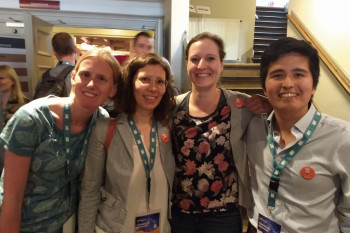© Pint of Science, 2024. All rights reserved.
If you commute regularly by train to your school or work, you have probably experienced this often. When the train doors open, people waiting to board, in other words boarding passengers, make two groups on either side of the doors, leaving space for deboarding passengers to leave the train. Most of the time, people follow this unwritten rule of waiting for deboarding passengers to leave the train before they get on. This unwritten rule appears to be a social norm. This means that people conform to it, believe it is the right thing to do, and expect others to do the same (Bicchieri, 2016). Social norms are generally beneficial for cooperation and social order (Legros & Cislaghi, 2020). Given that train boarding is not always a smooth and efficient affair, an important question arises: although boarding passengers follow a social norm and wait for deboarding passengers to exit the train, is this norm executed efficiently? In other words, do the boarding passengers who are waiting – especially when in larger numbers – leave sufficient space for deboarding passengers to exit the train quickly and smoothly?
Past research on train boarding shows that as the number of boarding passengers increases, the boarding process becomes slower, and thus less efficient (Seriani et al., 2016). However, it is unclear why this happens. Using both a physical and psychological perspective, in an interdisciplinary project conducted at TU Eindhoven, we set out to answer this question. Using anonymous pedestrian tracking data via commercial sensors installed at platform 5 of Utrecht Centraal station, we calculated how much space boarding passengers leave for deboarding passengers to exit the train. For 3278 boarding events, we measured the width of the deboarding corridor (the space left for deboarding passengers between the two groups of passengers). We found that as the number of boarding passengers increased and as the proportion of boarding to deboarding passengers increased (relatively more boarding passengers present at the door) the width of the corridor became smaller, and this in turn reduced how fast passengers could leave the train.
This research demonstrates that when bigger crowds are present, for example during rush hour, the boarding process is not as efficient even though most of the time, people follow social norms. So, what can we do to change this? One solution for this problem would be to denote clearly where boarding passengers should stand while waiting at the door. However, in the Netherlands, the trains do not always stop at the same position, so demarcating the platform floors may not work. Dynamic overhead light projections can be used to project lines in front of the train doors when they stop at the platform. Line markings can also be projected via lights on the train door itself. Over time, nudging people with line markings could develop into a social norm that people follow, and expect others to follow.
Another solution to ensure efficient boarding and deboarding is simply to distribute people across the platform. This has also been highlighted in earlier research (Kuipers et al., 2021). If people are concentrated at a few doors, these doors serve as bottlenecks and slow down the boarding process across the whole train. Distributing people would mean more or less equal number of boarding passengers at every door. Since a higher number of boarding passengers is associated with a narrower deboarding corridor, lowering the number of boarding passengers at the most crowded door will also prevent narrower corridors.
So, as a commuter who travels during rush hour where there are a lot of boarding passengers present at the train door, you can contribute to a smoother and more efficient boarding process by giving sufficient space to deboarding passengers, and by walking a little bit more to ensure distribution across the platform. If achieved on a broader level, this could also prevent train delays occurring due to passenger behavior and also contribute to an efficient train network for all.
About the author
Rabia Kodapanakkal is a postdoctoral researcher in the group Human-Technology Interaction at Eindhoven University of Technology. She is also part of the Crowd Flow Research group - https://crowdflow.phys.tue.nl/
References:
Bicchieri, C. (2016). Norms in the wild: How to diagnose, measure, and change social norms. Oxford University Press.
Kuipers, R. A., Palmqvist, C. W., Olsson, N. O., & Winslott Hiselius, L. (2021). The passenger’s influence on dwell times at station platforms: a literature review. Transport Reviews, 41(6), 721-741.
Legros, S., & Cislaghi, B. (2020). Mapping the social-norms literature: An overview of reviews. Perspectives on Psychological Science, 15(1), 62-80.
Seriani, S., Fujiyama, T., & Holloway, C. (2016). Exploring the pedestrian level of interaction on platform conflict areas at metro stations by real-scale laboratory experiments. Transportation Planning and Technology, 40(1), 100–118.


